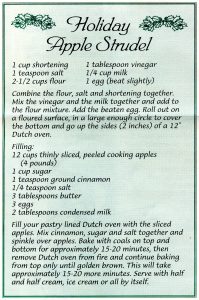Nostalgic Naturalist
Excerpt from The Ripple Winter 1998/1999
Before the present day park magazine, The Currents there was The Ripple. Started in winter of 1991, The Ripple was as a source for regional nature and history based articles, along with an additional insert for seasonal programs. The magazine was published at the beginning of every season featuring a diverse collection of material such as drawings by local artists, poems by naturalists, and even the occasional recipe straight from the miller. Continue to check the blog as we periodically throw it back to The Ripple days.
This piece was written by Bonneyville Mill Manager, John Jenney, as a part of the Winter 1998/1999 issue.
Holiday Dutch Oven Cooking
December brings many things to mind. Some think of the cold and snow while others think of parties and presents. The truth is that nothing warms the cold winter months quite as much as holiday activities.
I enjoy the 4 F’s of the holiday season: Family, Fun, Fellowship and, last but not least, Food. Holiday food comes in many shapes and forms but to me it all tastes better when it’s prepared in a Dutch oven.
That’s right….winter is not time to store away your Dutch ovens. Cooking with cast iron can be a fun and unique way to serve up your holiday delights.
- What is a Dutch oven?
- A Dutch oven is a deep cast iron pot that stands on three legs. The cast iron lid is dished to allow hot coals to be placed on top.
- Dutch ovens come in many sizes to accommodate any size group.
- Do I have to cook outside with my Dutch oven?
- I use a Dutch oven inside or outside. A small Dutch oven can fit easily inside your kitchen range. I encourage you however to cook outside thus adding to the ambiance of your oven.
- How many charcoal brickets do I use?
- You can maintain 350 degree heat in your oven by placing the correct number of charcoal brickets on top and underneath your oven.
- This is done by taking the size number of the oven using that many coals plus 3 on the top and minus 3 on the bottom. For example, when using a #10 Dutch oven, place 13 coals on top and 7 coals on the bottom.
- In the winter you may need to compensate for cold temperatures with a few extra coals.
- Isn’t cast iron hard to care for?
- When your Dutch oven is seasoned, most of the work is already done for you. The non-stick, carbonized surface can be easily wiped clean in most cases.
- The two rules after seasoning are: No Soap and No Abrasives.
- Your season Dutch oven is like a Teflon pan…the seasoning can be scraped off. To remove sticky stuff, use plain hot water and a Teflon-safe scrubber.
- How do I season my Dutch oven?
- First, clean the entire oven inside and out. Coat the oven inside and out with Crisco shortening. Place the oven in your kitchen range at 350 degrees for 10 minutes. Remove the Dutch oven and wipe out the excess pooled grease. Then return it to the range and bake for at least 1 hour.
- Season the lid the same way.
- Don’t cook watery recipes for the first several times to allow the Dutch oven to fully season.
- Where do I get a Dutch oven?
- Many local stores probably carry cast iron cookware. The best local selection I’ve seen is located at Yoder’s Department Store in Shipshewana.
Now that you know a little more about Dutch oven cooking, you will be able to wow the whole family with a special holiday dish cooked up in your very own Dutch oven.
To find a good selection of recipes and good Dutch oven advice, go to your favorite bookstore and ask for the following book: World Championship Dutch Oven Cookbook, Watkins Printing, Inc. 1989, by Kohlers and Michauds.




